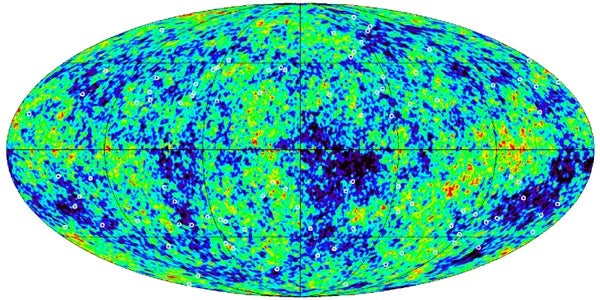New research by astronomers at Durham University in the United Kingdom suggests that the conventional wisdom about the content of the universe may be wrong. Utane Sawangwit and Tom Shanks looked at observations from the Wilkinson Microwave Anisotropy Probe (WMAP) satellite to study the remnant heat from the Big Bang. The two scientists find evidence that the errors in its data may be much larger than previously thought, which in turn makes the standard model of the universe open to question.
Launched in 2001, WMAP measures differences in the cosmic microwave background (CMB) radiation, the residual heat of the Big Bang that fills the universe and appears over the entire sky. Scientists think the angular size of the ripples in the CMB is connected to the composition of the universe. The observations of WMAP show that the ripples were about twice the size of the Full Moon, or around 1° across.
With these results, scientists concluded that the cosmos is made up of 4 percent “normal” matter, 22 percent “dark” or invisible matter, and 74 percent “dark energy”. Debate about the exact nature of dark matter and dark energy continues today.
Sawangwit and Shanks used astronomical objects that appear as unresolved points in radio telescopes to test the way the WMAP telescope smoothes out its maps. They find that the smoothing is much larger than previously believed, suggesting that its measurement of the size of the CMB ripples is not as accurate as was thought. If true, this could mean that the ripples are significantly smaller, which could imply that dark matter and dark energy are not present after all.
“CMB observations are a powerful tool for cosmology, and it is vital to check for systematic effects,” said Shanks. “If our results prove correct, then it will become less likely that dark energy and exotic dark matter particles dominate the universe. So the evidence that the universe has a ‘dark side’ will weaken.”
In addition, Durham astronomers recently collaborated in an international team whose research suggested that the structure of the CMB might not provide the robust independent check on the presence of dark energy that it was thought to.
If dark energy does exist, then it ultimately causes the expansion of the universe to accelerate. On their journey from the CMB to telescopes like WMAP, photons — the basic particles of electromagnetic radiation including light and radio waves — travel through giant superclusters of galaxies. Normally a CMB photon is first blueshifted — its peak shifts toward the blue end of the spectrum — when it enters the supercluster and then redshifted as it leaves, so the two effects cancel. However, if the supercluster galaxies are accelerating away from each other because of dark energy, the cancellation is not exact, so photons stay slightly blueshifted after their passage. Slightly higher temperatures should appear in the CMB where the photons have passed through superclusters.
However, the new results based on the Sloan Digital Sky Survey, which surveyed 1 million luminous red galaxies, suggest that no such effect is seen, again threatening the standard model of the universe.
“If our result is repeated in new surveys of galaxies in the Southern Hemisphere, then this could mean real problems for the existence of dark energy,” Sawangwit said.
If the universe really has no dark side, it will come as a relief to some theoretical physicists. Many scientists feel uncomfortable having a model dependent on as yet undetected exotic particles that make up dark matter and dark energy. It also throws up problems for the birth of stars in galaxies with as much feedback energy needed to prevent their creation as gravity provides to help them form.
“Odds are that the standard model with its enigmatic dark energy and dark matter will survive, but more tests are needed,” said Shanks. “The European PLANCK satellite, currently out there collecting more CMB data, will provide vital new information and help us answer these fundamental questions about the nature of the universe we live in.”










